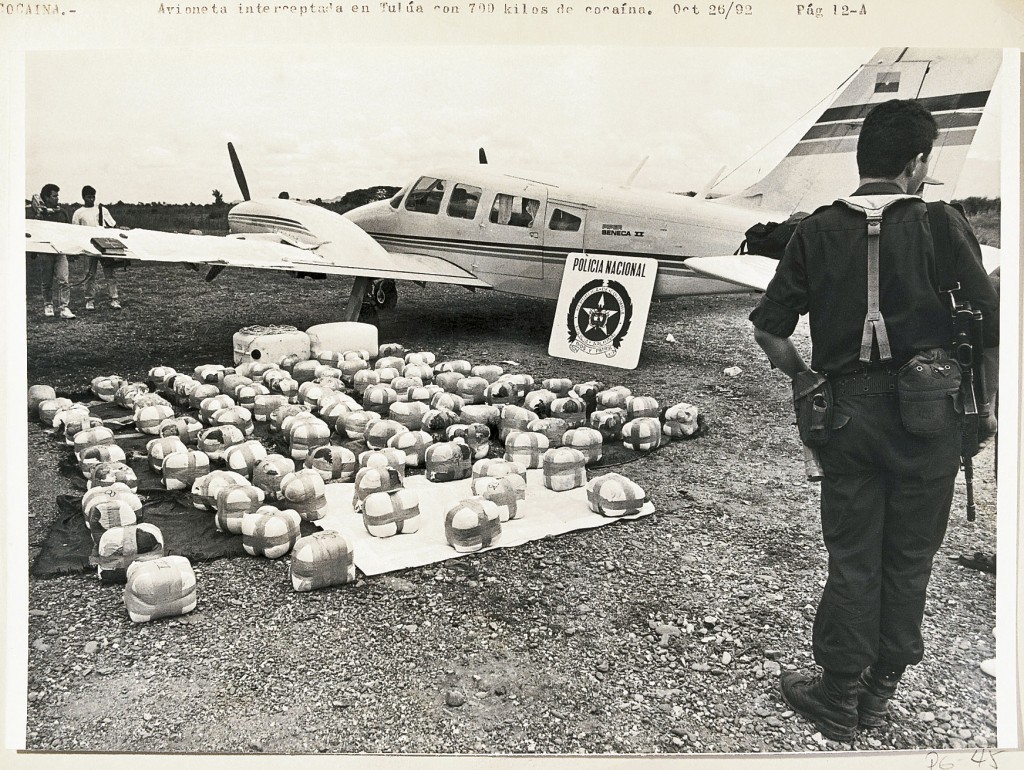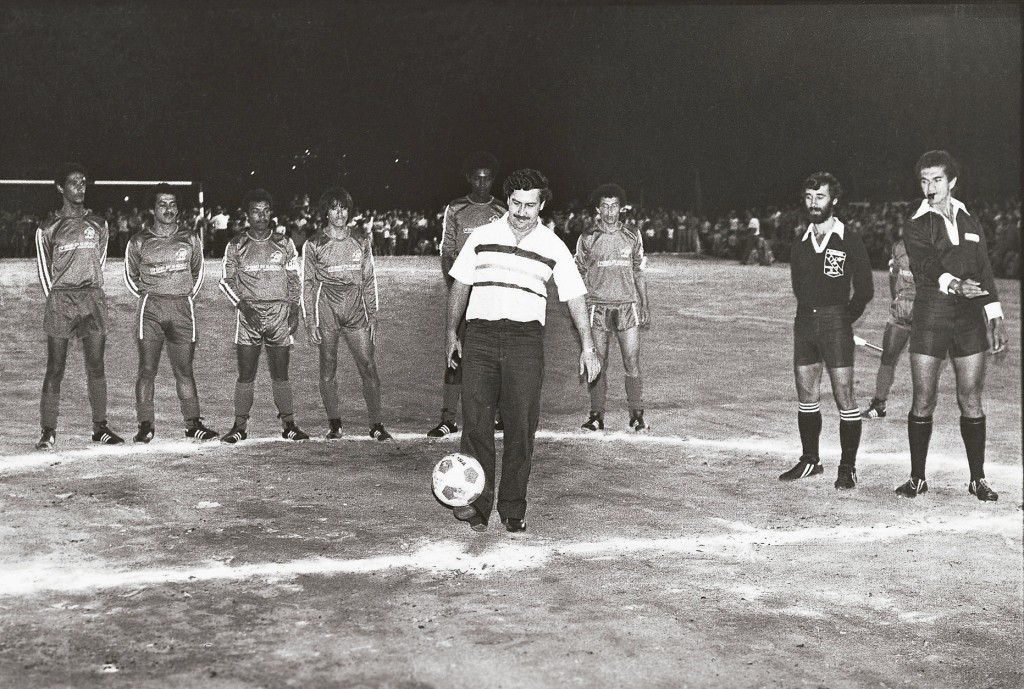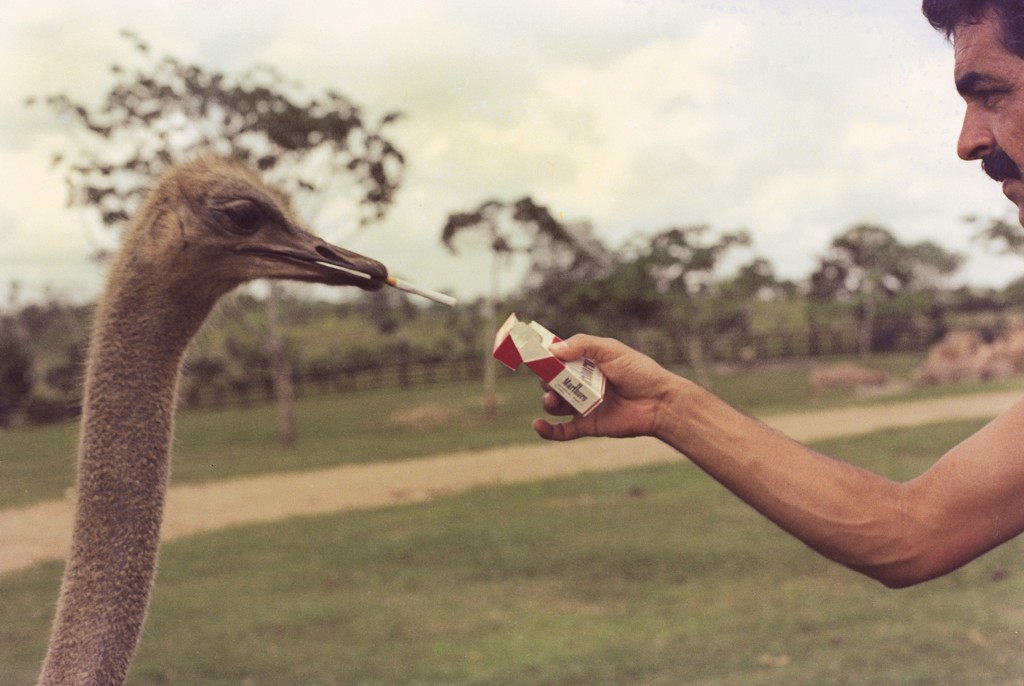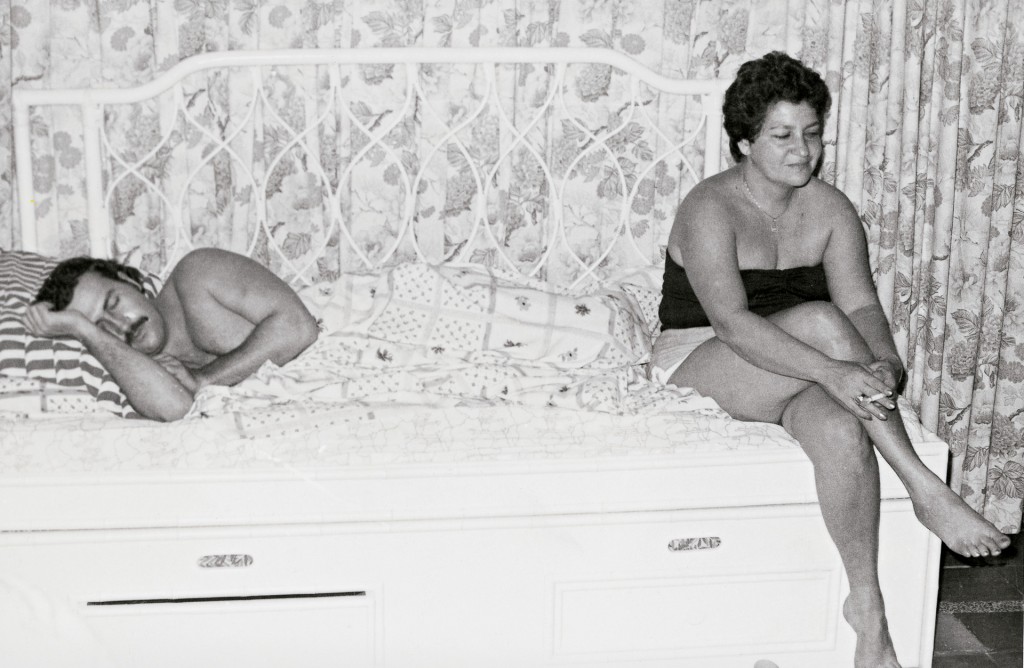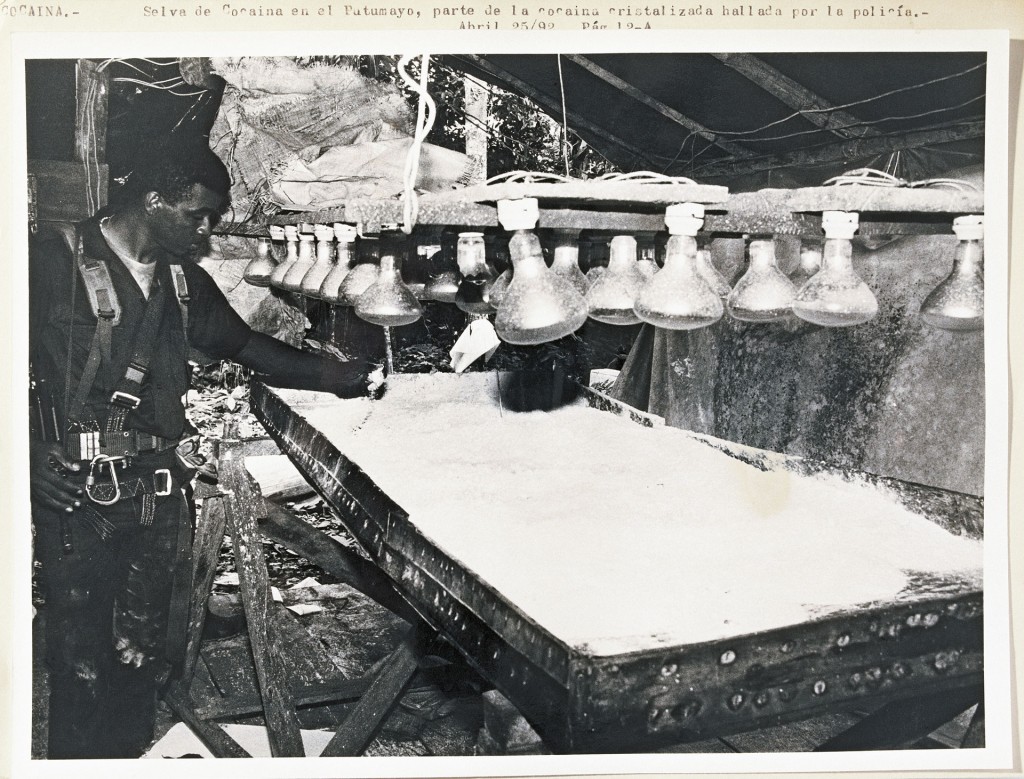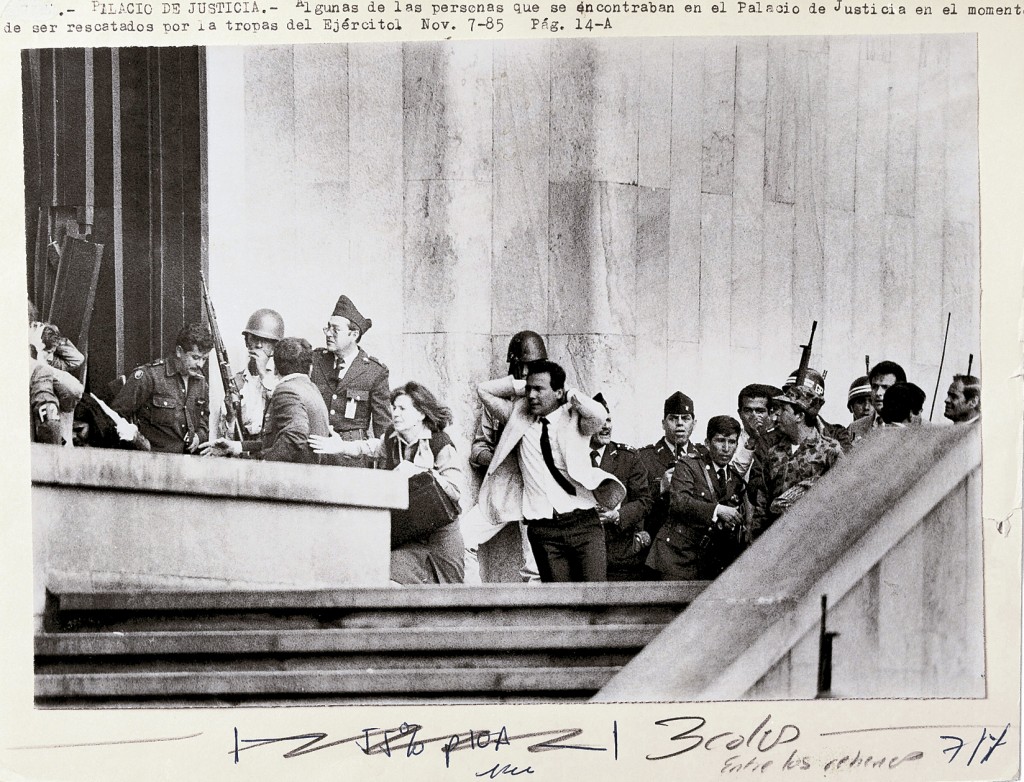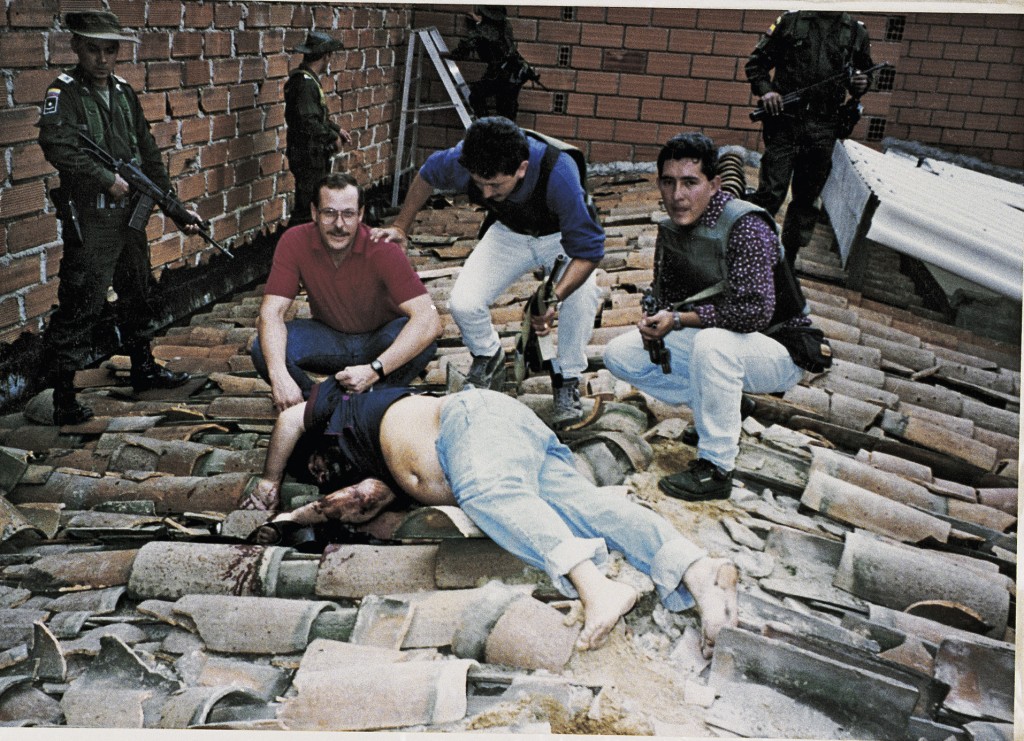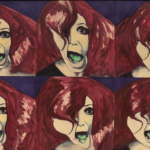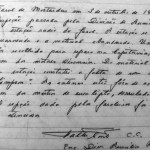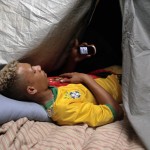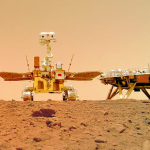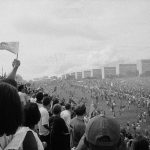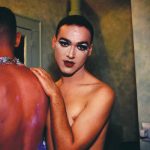Pablo Escobar – The Album
Publicado em: 9 de December de 2013The British photographer and researcher James Mollison spent almost three years in colombian photography libraries and collections in search of the drug dealer. With images amassed from police collections and the principal newspapers, and from albums put together by his family and thugs, Mollison reconstructed Escobar’s life. The photographs reveal his public and private life, his criminal activities and the terror he instigated. Twenty years after his death, films and TV series have reignited interest in the dealer.
His 150 kilos are splayed over the peak of the roof. Perhaps his bare feet broke those tiles a few minutes before, scattering their fragments around. His bare belly is exposed, bulging out between his blue shirt and jeans, cultivated by the long, inactive months in hiding.
His head, the long hair matted with blood, will soon be despoiled by his killers, as they collect locks of hair and the ends of his moustache as trophies, leaving him looking like Hitler, according to the New York Times obituary. The newspaper also reported that the body was recognized by fingerprints and a 10cm crucifix on its left shoulder.
Years later, the Colombian novelist Héctor Abad wrote about the scene: “It is right that no one should rejoice in anyone’s death. But that body, evil incorporated, slaughtered, that belly in the air, a pistol in its hand, that corpse finally incapable of planning murders, kidnappings and terrorist acts did not sadden us. His violent death, by the same law of the jungle he had imposed, represented the beginning of the redemption of a country, bleeding from many evils, but especially the sophisticated, precise, pure, intelligent evil emanating from this one man: Pablo Escobar.”
It took 20 years for the name Escobar to migrate from the crime reports to the entertainment pages. Directly responsible for about 4,000 deaths, which led Colombia into an unbearable spiral of violence, Escobar is now the subject of books, TV series, feature films and documentaries. The European feature film Paradise Lost was shot in 2013, with Benicio del Toro in the lead role. In Brazil, José Padilha, director of Elite Squad, is preparing a TV series based on the drug-dealer’s story.
Escobar cultivated a relationship with photographers and let them click away at will, at least while his political ambitions lasted. He is portrayed as an Al Capone or Pancho Villa. He started to wear a Russian fur hat as if it were a revolutionary beret and posed with it for photographers behind the bars of his prison-mansion, La Catedral. In the midst of a campaign of threats and attacks against the newspaper El Espectador, he sent a message to the editor: “you’re lacking imagination when you try to get new photos of me, you need to try harder.”
“Bandits have always been fascinating in popular culture,” Abad told ZUM. “Pablo Escobar was poor and ended up becoming the richest man in Colombia. A story like that never ceases to arouse admiration. People tend to forgive the very rich for everything.” So it wasn’t by chance that following the success of the TV series Pablo Escobar, El Patrón del Mal [Pablo Escobar, The Drug Lord] in 2012, a clandestine sticker album became such a fad in Medellín, with its real images of the capo and his properties.
“The Bible doesn’t really work without Judas, the fallen angel, or the demons,” the writer said when asked about the posthumous Escobar cult. He knows about what he speaks: his father, the hygienist Héctor Abad Gómez, was murdered in 1987 by paramilitaries, whose violence Escobar gave space to. “We have a need to see representations of the devil, because evil and evil people undoubtedly exist and will always be a temptation, as in the Catholic faith, but in an Earthly sense, not a religious one.” For Abad, the antidote to this temptation is to show how Escobar got where he got: at the cost of deaths and suffering.
A Photographic Hunt
The British photographer and researcher James Mollison became aware of the story of Pablo Escobar in 2002, during a photo session in the Valledupar prison. One of the prisoners he met was Popeye, Escobar’s head of security and one of the few survivors of the Medellín Cartel. It was he who awakened Mollison’s interest in the drug baron’s trajectory. Later, while photographing a building used by Colombia’s Public Prosecutor, which had housed Escobar, Mollison met Manuel Dario Aristizabal and was shown a bag full of images of Pablo. He would soon become fascinated by the mythology surrounding this mobster who liked to be photographed.
“The big gang bosses who came after learned from that mistake and did everything possible to remain anonymous,” says Mollison. “Escobar acted the way he did because there was a time in the late 1970s when cocaine was known as white gold, and Pablo believed that drug money would not be seen differently from the money earned from bootlegging [during Prohibition in the USA in the 1920s] that had helped make the Kennedys the most powerful dynasty in the United States.”
Over the years that followed, Mollison scoured police records, the principal Colombian newspapers and also got in touch with Escobar’s family and thugs, gathering valuable material. The material was rich enough to put together a picture of the trafficker’s different faces. The result of this research was published in his book The Memory of Pablo Escobar, released in the USA in 2007. Mollison reckons, however, that the nearly 400 photos in the volume are no more than 10% of the material he found.
There can be seen the same pictures which featured in that informally published sticker album: a collection of old cars; the gateway to the Nápoles farm, ornamented with one of the small planes that carried Escobar’s cocaine to the United States; the five-star La Catedral prison. But there are also photographs of his victims, mangled corpses, scenes of bombings, murders and other crimes, in a mix of affection and violence that does, in fact, help us to understand him a bit better. “The book is as much about Pablo as about rooting through personal and institutional archives, with accompanying documentation which remains open to questioning and interpretation,” Mollison told ZUM.
What is immediately obvious in the images is the apparently absolute normality of Escobar and his entourage. Family and friends enjoying themselves at home or on the farm. Ruthless killers frolic at the poolside with their girlfriends. His biographer Alonso Salazar J. writes in The Parable of Pablo: “He was such a good father that he hid from his kids when he smoked a joint, his only permanent vice.”
Drug Trafficking – The Golden Years
Pablo Escobar’s story is the ground zero of a problem that would grow to calamitous proportions: cocaine trafficking and the consequences of the drug war proclaimed by the United States in the 1990s. Escobar’s Colombia is a preview, though to a lesser extent, of the barbarism of the Mexican cartels, which has grown since the middle of the last decade. According to the mantra entoned by drug trafficking experts, successful repression in one country only leads to the violence migrating somewhere else. Indeed, from 2001 to the present, Colombia has dropped from the world’s first to third largest producer of cocaine, after Peru and Bolívia.
The mid-1970s were idyllic times for drug trafficking. A handful of kidnappers and traffickers succeeded in making Medellín, Colombia’s second city and capital of the mountainous department of Antioquia, the operational centre for the supply of cocaine to the U.S. market, handling 80% of the product. The prices were mind-boggling, the risks relatively low while their daring was extreme.
Alongside his cousin and partner Gustavo Gaviria, Escobar led the Medellín Cartel, which included dealers such as the Ochoa family (horse breeders whose “hobby” was exporting cocaine), José Gacha (“El Mexicano”) and Carlos Lehder.
Considered a “visionary”, Lehder made the leap in ambition that led to Escobar and him occupying the top position in the World’s Richest and Most Wanted lists at the same time. The idea was simple and ingenious: get cocaine into the United States in small aircraft, flying a few meters above the ocean (and therefore invisible to radar), with refueling stops in the Caribbean. Suddenly it became feasible to transport tons, not the meager kilograms hidden away in jacket linings, false suitcase bottoms or inside the bodies of “mules”, which was the norm until then.
Escobar showed a remarkable ability to create innovative and enduring multiple trafficking routes, using every type of transport and route open to him, even going through Africa to get to American soil. He pioneered the transport of cocaine in ex-Soviet submarines, bought from Eastern European mafias, and semi-submersibles built from fibreglass and powered by truck engines. The Medellín gunmen created a thriving business, with a hierarchical organisation worthy of a multinational.
The capo’s headquarters was the Nápoles farm, from where his aircraft departed laden with the powder – sometimes four in one day. That was where the heads of the cartel had their meetings in a party atmosphere. And that was where he set up his famous zoo, with its elephants, giraffes, zebras and other exotic animals. All that remains now are the hippos, the only ones succesfully breeding in the wild outside Africa.
Politics
Escobar wanted to be recognized as a benefactor and carefully prepared for his entry into the political arena, forging the myth of the protective, fatherly and open-handed dealer who would compensate for the absence of the State by distributing medicine, houses and soccer fields to the poor.
The Italian photographer Giovanna Pezzotti managed to get close to Pablo Escobar during a long season in the early 1980s, taking shots of him campaigning, on feast days and even during hunts, after which he would stick and bleed the prey himself and roast them on the barbecue.
At the height of his prestige, the godfather even went to Madrid for the inauguration ceremony of Spanish Prime Minister Felipe González in 1982. He would go to Miami using a real passport and visa and do business just like any other executive. Behind this facade, however, he enforced his own business logic. It boiled down to the classic dilemma “plomo o plata” (literally “lead or silver”): anyone who resisted corruption and refused the money ended up shot dead. No other alternative was offered.
Elected to the Colombian Congress in 1982, the origin of Escobar’s fortune was questioned by fellow-Congressman Rodrigo Lara Bonilla. Escobar had been careful not to leave clues about his real activities, claiming to have got rich through industry, construction and agriculture. For the first time, the country paid some attention to this shady millionaire, who had gone so far as to build an entire new neighbourhood for the population living on a rubbish dump, today known informally as Barrio Pablo Escobar.
One of those responsible for unmasking him was Guillermo Cano, a journalist at the Espectador, who looked at his face and had the nagging suspicion that he had already seen it somewhere else. After a search through the newspaper archives, Cano found and re-published a mugshot of Escobar, smiling for the camera and mocking the police officers at the time of his first arrest for cocaine trafficking in 1976. It was the proof that was needed to confirm all the rumours. Escobar found himself cornered and finally expelled from party politics.
Lara Bonilla and Cano were not forgotten for the episode: the first was assassinated in April 1984 when he was Minister of Justice and had just led the assault on Tranquilandia, a complex of laboratories in the middle of the jungle that produced more than 20 tons of cocaine per month. Cano was executed in 1986. El Espectador, which continued with its exposures of drug traffickers, had its newsroom destroyed by a bomb in 1989. Luis Carlos Galán, who was leading the election race in 1989, was also assassinated during a rally. With such illustrious victims, Escobar created chaos in the country’s political system.
Outsourcing
As well as the desire for revenge, these crimes have another common factor – “outsourcing”. Just as with legitimate businesses, some work was contracted out. Though in this case it was gangs of gunmen who were hired together to carry out a hit. A network of gangs grew up in Medellín and “provided services” to Escobar – and sometimes to his enemies, such as the Cali Cartel, which funded an attempt to blow up the Monaco building in 1988 – Escobar’s luxurious family residence.
From judges, Justice Ministers, Presidents and presidential candidates to ordinary street cops, any representative of the State became a target of the Medellín Cartel. Escobar paid their killers on the basis of a price list, the amount varying according to the status of the victim. The police retaliated with random massacres in poor neighbourhoods: the homicide rate reached 381 per 100,000 inhabitants. In 1991 alone, over 7,000 people were killed in Medellín.
The Extradition Law
As soon as a 1979 law opened up the possibility of Colombians being extradited and prosecuted in other countries, Escobar and the other capos worked together to repeal it. Under their self-given title Los Extraditables, their slogan was “We prefer a grave in Colombia to a cell in the United States.” Unpunished in their own country, they feared they would not escape the American justice system, which had already gathered evidence against them.
Escobar promised to give himself up if the extradition law was repealed. He promoted a campaign to persuade the public that the law was actually the source of the violence. To support this argument, they bombed, assassinated and kidnapped officials, entrepreneurs and progressive militants. Many saw this open war against the State as Escobar taking revenge for his expulsion from politics.
The most impressive action was the attack, on November 6, 1985, on the Palace of Justice in Bogotá. It killed more than 100 people, including 12 judges of the highest court in the country. The bombing was funded by Escobar and carried out by M-19 guerrillas.
The Cathedral
In 1991, the extradition law was finally declared invalid. Escobar then agreed to surrender but imposed his own conditions, which were accepted by President César Gaviria, who two years before had escaped an attack during his presidential campaign when Escobar blew up an Avianca plane in flight. Biographers and journalists are unanimous in their view that Escobar’s arrest and imprisonment in “maximum security” was for show – a piece of theatre for the Americans. The “prison” was built by Escobar himself, in a location of his choice. The guards were his own henchmen. It all served more to protect him – from the State, the Cali Cartel, and the Los Pepes (Personas Enemigas de [the enemies of] Pablo Esbobar), a group set up to avenge his victims – than to punish him.
Collected together in Mollison’s book, the images of the capo in La Catedral exude normality. As always, there he had fun, organised orgies and committed crimes, such as the summary execution of two ex-associates accused of betrayal.
When the death of his old henchmen became known, it became impossible for him to remain in La Catedral, where the permissiveness demoralised the authorities – inside and outside the country. On July 22, 1992, Escobar took the negotiators, who were dealing with his transfer from La Catedral, hostage and fled with nine of his men through a secret exit that he himself had built into the prison’s wall. And so began the final hunt for a man whose life was not in the interest of anyone anymore.
Achilles’ Heel
Escobar’s Achilles’ heel was precisely that which surprises those who examine the mundane records of his private life: his umbilical link with his Family.
Increasingly driven into a corner, Escobar negotiated political asylum for his wife and children in Germany. They embarked for Germany on November 27, 1993, but at the request of the Colombian government, asylum was revoked by the German government, so the Escobars returned to Colombia, where they remained under official protection in a military residence. Pablo Escobar’s most cherished property was in the hands of his greatest enemy.
From there to breaking the most basic security rules was a small jump. Even though he avoided lengthy telephone conversations, Escobar was tracked by a new type of radar that Americans had given to the Colombians. Installed in an aircraft, the equipment was able to recognize voices by their frequency patterns and triangulate the location of the transmitter.
As he dictated answers to an interview for a German magazine to his son, Escobar heard a helicopter and the sound of soldiers surrounding his house, situated in an wealthy Medellín neighbourhood. “I’ll call you back,” he told Juan Pablo and, with a 9mm pistol in his hands, jumped through a window to get to the roof. It was December 2, 1993. The day before he had turned 44.
Escobar was shot in the leg and shoulder. The bullet that killed him entered through his right ear and left in a perfect trajectory by the left ear. That’s what the coroner’s photos show.///
Paulo Werneck, a journalist and editor, is curator of the 2014 International Literary Festival (FLIP) in Paraty.
James Mollison (1973) was born in Kenya and grew up in England. He is a photographer and researcher. He lives in Venice.
///
Get to know ZUM’s issues | See other highlights from ZUM #5 | Buy this issue


